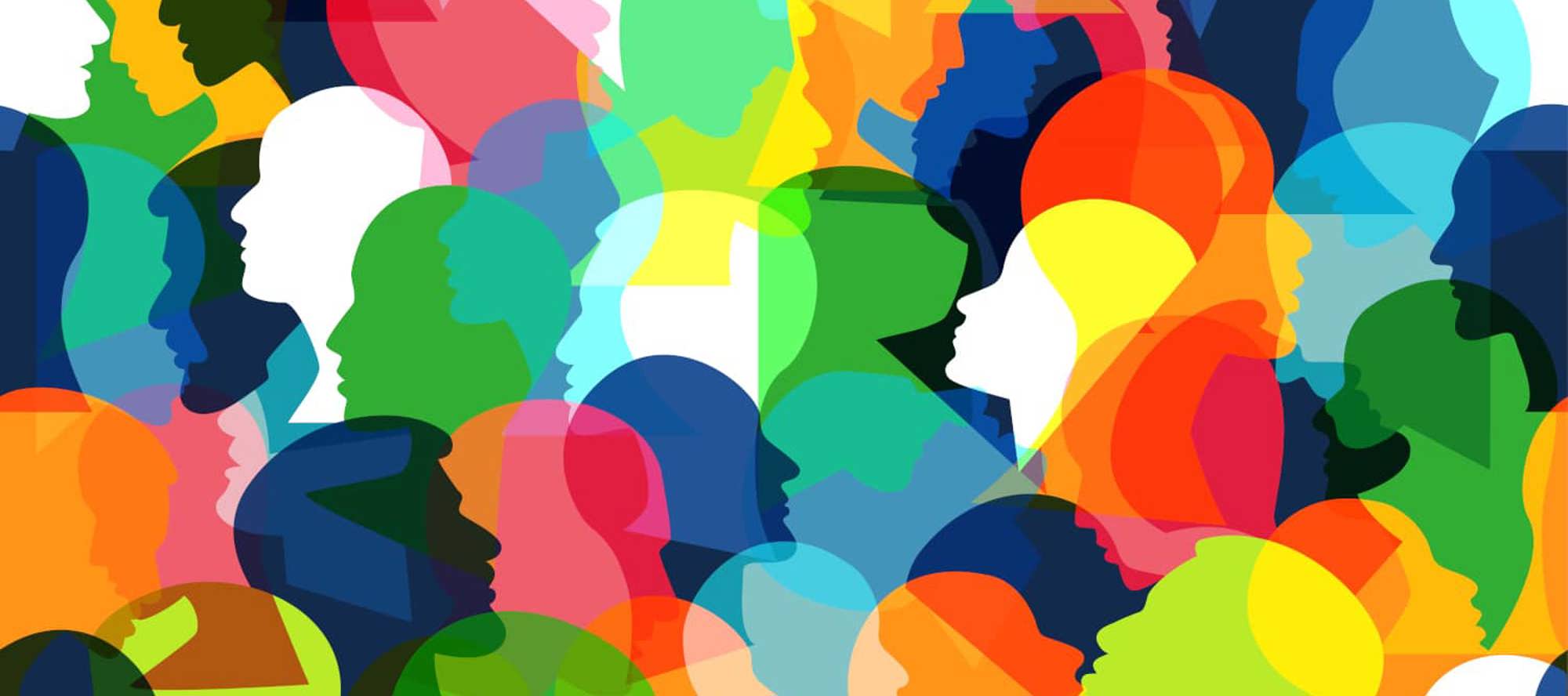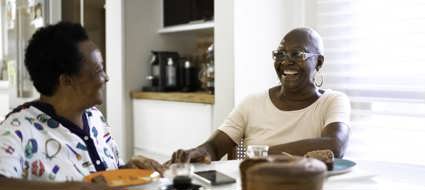Discriminatory abuse – developing practice responses
Published:
This podcast explores what discriminatory abuse is and considers official statistics and wider research findings. It discusses how we can recognise potential discriminatory abuse, how discriminatory abuse features in Safeguarding Adult Reviews and what this means for developing our practice.
Karl Mason, Lecturer and BSc Social Science Programme Lead at the Department of Law and Criminology of Royal Holloway, University of London talks with Dyfrig Williams (Head of Learning at Research in Practice) about discriminatory abuse, its policy basis and what effective practice might look like.
In this podcast, we look critically at what common discriminatory abuse is and consider official statistics and wider research findings. We look at how we can recognise situations where discriminatory abuse might apply and how it has arisen in Safeguarding Adult Reviews, and what this means for how we might develop our practice.
Talking Points
This podcast looks at:
- What is discriminatory abuse?
- What examples of discriminatory abuse might look like.
- Developments for practice.
- Useful national and local resources for those who work with people who have protected characteristics.
[Introduction]
This is a research in practice podcast supporting evidence informed practice with children and families, young people and adults.
Dyfrig: So, hello. Welcome to this research in practice podcast. I'm Dyfrig Williams, I'm the Head of Learning here at Research in Practice. This podcast will be looking at developing practice resource around the discriminatory abuse. Today, I'm talking with Karl Mason, who's a lecturer and social worker at Royal Holloway University of London. Karl, can you introduce yourself please?
Karl: Hello everybody. Hello Dyfrig, yes, thank you, my name's Karl Mason and I, like, like you've said, I'm a lecturer and social worker and I've been doing some work over the last year and a half with some colleagues in the local government association and with some of your colleagues, Dyfrig, at research in practice in relation to discriminatory abuse. And I'm looking forward to sharing some of that knowledge today with everybody listening.
Dyfrig: Brilliant, thanks Karl. So today, we're going to be looking at what discriminatory abuse is and its policy basis, we're gonna be thinking critically about how does, how common discriminatory abuse is and consider official statistics and wider research findings. We're gonna be looking recognising situations where discriminatory abuse might apply, as well as how discriminatory abuse has arisen and safeguarding outlook reviews and we're also going to be considering how we might develop our practice in relation to discriminatory abuse. So we're gonna be covering a lot and I'm really looking forward to it. Before we delve into the podcast then, Karl, is there anything important for us to think about at the start of this?
Karl: Yeah, I think that it's, it's important to remember that this podcast is, is about a very serious topic. It's about safeguarding adults and it's about how adults may be targeted as a result of their protected characteristics. And so, as a result, I'm aware that people will be listening to the podcast, maybe in different sorts of scenarios. Some people might be at home with other people around, some people might be in the office, some people might be on public transport, but it's just important to remember that there, there, there will be some sensitive topics discussed. We're going to talk about some serious case reviews or safeguarding adults reviews, talking about safeguarding adults reviews, always involves telling very sensitive stories and stories that are very tragic, really, that, that, where people have been harmed. And, of course, you know, we're engaging with issues such as ageism and racism and homophobia and transphobia and Islamophobia and other forms of discrimination and obviously, it's important to just take of ourselves while we're listening to this podcast and while we're doing this work, more generally. So, I think, yeah, that's, that's an important thing to say just in terms of self care at the start.
Dyfrig: So, Karl, to start off with then, we'd, can start with thinking about what discriminatory abuse is. How would you explain discriminatory abuse to practitioners listening who may or may not be familiar with it?
Karl: Discriminatory abuse is a category of abuse in safeguarding adults, which has been around in policy since, really, the no secrets guidance document from 2000 and it's been retained in the care and support statutory guidance, which supports The Care Act. So the care and support statutory guidance defines discriminatory abuse as forms of harassment, slurs, or similar treatment because of race, gender and gender identity, age, disability, sexual orientation and religion. So in other words, it's a category of abuse in safeguarding adults policy and it refers to various forms of abuse that are ultimately motivated by prejudice or bias and that includes prejudice or bias that's targeted in relation to those who have protected characteristics. And, in terms of how I would explain it beyond the statutory definition, I suppose that it can be helpful to illustrate this with examples from safeguarding adults reviews or what were previously called serious case reviews. There are two fairly high profile serious case reviews, which predate The Care Act, but which are still cited regularly in relation to really illustrating and getting to know above what discriminatory abuse is. So I might just tell people a little bit about these two serious care reviews, just at the outset. The first of these was Fiona Pilkington and her daughter, Francecca Hardwick. So, they lived in Leicestershire and over a period of ten years, they experienced severe harassment by local youths. Sadly, Fiona Pilkington ended her own life and that of her eighteen year old daughter, Francecca Hardwick, who had learning disabilities.
And the serious case review noted that they had been targeted as a result of Francecca's learning disability in quite a severe way but that the multi-agency network had failed to identify this beyond, sort of, episodes of anti-social behaviour and had failed to, to notice the patterns of discriminatory behaviour that was-, that was ongoing for over, for a decade. So, obviously, that's one extremely tragic case and, and another that people might be familiar with is Steven Hoskin. Now, Steven Hoskin, many people will be aware, was a 39 year old man with learning disabilities. Steven had, had moved to semi-independent accommodation away from his home town in Cornwall when he was befriended by a local gang and he was befriended by this gang, they, they moved into his flat. They began to take advantage of him as a result of his learning disabilities and unfortunately, and very tragically again, Steven was murdered by this group of people and again, the serious case review noted that, that this had happened as a result of being targeted because of his learning disability and unfortunately the multi-disciplinary network had not acted when he had made numerous calls to health and social care services, to housing, to the police. So there were issues of communication and information sharing in this situation. So these are two, sort of, fairly high profile serious case reviews that people may have heard of but they really illustrate the ways in which very tragic outcomes can occur and the ways in which people can be targeted as a result of their protected characteristics.
Dyfrig: Thanks Karl. That's really helpful to understand and to hear those examples. How do you think discriminatory abuse operates alongside other safeguarding adults categories?
Karl: Well, that's a really, really good question Dyfrig. I think one of the issues with discriminatory abuse is that it doesn't operates on its own. People can be targeted as a result of their protected characteristics, but oftentimes, that targeting is implemented through, say, physical abuse or financial abuse or, say, emotional abuse. And so racist motivations can be carried out through an assault, for example, or through emotional abuse or bullying, for example, and other forms of harassment. So because it's implemented through other categories of abuse, like physical abuse, sometimes it can be hard to recognise it as abuse in its own right because the more obvious form of abuse may be the mode through which its implemented. So racist abuse, which is implemented through physical abuse, it might be easier to identify the assault for example and it might be harder to, to identify the less recognisable aspects of, of this because discriminatory attitudes can be hidden. I think as well as that there can be overlaps with, say, hate crime or mate crime. And it's useful just to think about what things are. So Mencap talk about mate crime as being something that happens when someone says that they're your friend but they end up taking advantage of you, like, for example, taking financial advantage of you or, or some of those things that happened to Steven Hoskin, where his flat was taken over and he was exploited by people who said they were-, they were his friend. Whereas hate crime is something that happens where somebody targets you because of who you are because of the, the characteristics, the protected characteristics that you have. For example, race or sexuality or disability or, or age.
I, I say protected characteristics but it doesn't necessarily have to follow that we're talking about the characteristics listed in The Equality Act, it could be, for example, that somebody is targeted as a result of other things like, like homelessness. And, yeah, I suppose it can be helpful just to think back to Steven Hoskin and Fiona Pilkington so both were targeted as a result of the characteristics that, that Steven Hoskin and that Fiona Pilkington's daughter, Francecca Hardwick had. So, yeah, those are some of the ways in which discriminatory abuse can operate alongside other categories and that is implications, really, for how, how it's reported which we might get to a little bit later in the-, in the podcast.
Dyfrig: Thanks Karl. So it sounds like it could be a commonly used category as it's quite flexible and works alongside those other categories.
Karl: Yes, because when you think about it, every adult, I think, that comes under the safeguarding adults umbrella, will have care and support needs and oftentimes, these will be as a result of age or disability and both age and disability are protected characteristics. And, if somebody is targeted as a result of age or a disability, then you could say that that is an example of discriminatory abuse. And, of course, older people and people with disabilities and people who are experiencing mental distress, they often have other characteristics, multiple characteristics, in relation their identities, whether that's in relation to race or sexuality or gender identity or religion. So, you could think that it would be quite a commonly used category but you would be wrong, unfortunately. So the reporting statistics on discriminatory abuse are extremely low. Last year, less than 1% of section 42 safeguarding enquiries were linked to discriminatory abuse and, although this has increased very slightly in 2021/22, it's only increased to 1.5% of section 42 enquiries linked to discriminatory abuse. So that is extremely low. If we look, then, at safeguarding adult reviews, there was a really good piece of work done, in fact, it was the first national analysis of safeguarding adult reviews and it was done by Michael Preston-Shoot and A D Cooper and a range of other people, and they analysed all of the safeguarding reviews between 2017 and 2019 and they found that only two of the 399 safeguarding adult reviews done in that period were linked to, explicitly, to discriminatory abuse. So the reporting, both in the safeguarding inquiry stats and in safeguarding adult reviews, it's really quite low. You'll find that there are some contradictions here.
So if you look at rates of reported disability hate crime, which is a criminal offence that would be reported to the police, but has a lot of cross over with discriminatory abuse, we'll note that, in fact, so last year, there were 9,208 police recorded disability hate crimes and that was in 2020, 2021. And that was a 9% increase on the year before but, in fact, that's now increased from 9,208 to 14,242 in 2021, 22. That's a 43% increase in one year. So this is really quite phenomenal that people who are targeted, as a result of disability, and they report this as a-, as a hate crime to the police, that that's increasing dramatically but our, our discriminatory abuse statistics in safeguarding adults remain very low and very static. The reporting, I guess, on discriminatory abuse is unlikely to be accurate. Unlike hate crime, which is mainly self reported to the police, discriminatory abuse is based on practitioners recording the categories of abuse while they undertake their safeguarding duties, their section 42 inquiries. So I guess, you know, what we end up with is, is perhaps not the full picture, and it's likely that the, the category of discriminatory abuse is either hiding behind other, other manifestations of abuse, or, or not being reported for, for possibly some, some other reasons.
Dyfrig: That's fascinating to hear. Can you talk us through any interesting research findings around that?
Karl: Certainly. So myself and some colleagues from the Local Government Association and some colleagues from research and practice undertook a literature review earlier on this year. It was published in the Journal of Adult Protection, and so we found a fair few pieces of research that might help to understand why reporting might be low. So one interesting piece of work was done by Sue Westwood, who was particularly interested in discrimination and older LGBTQ plus people, and she talked about how discrimination links with protected characteristics, and as a result, people might be afraid of stigmatisation. It might be embarrassing, or people might feel, I guess, feelings of shame, and these things might prevent people from speaking up or asking to speak to a professional about discrimination. So it could be-, it could be embarrassing to speak to a professional, perhaps as a result of homophobia or transphobia. You might not trust the professional. So these sorts of things are talked through in Westwood's research, and there was another interesting piece of research done about a decade ago by SIN, and SIN talks about just the commonplace nature of discrimination in society. So some people experience discrimination on an everyday basis and we know a little bit more about that with the coverage from the Me Too social movement and the Black Lives Matter social movement, where everyday sexism and everyday racism have been sort of detailed a little bit more, brought to-, brought, brought to more prominence in, in the public imagination. So I suppose as a result of the everyday nature of, of some forms of abuse, these experiences can be normalised. It can be difficult to identify these everyday experiences as abusive, and that could lead to, to low reporting.
Sarah Carr and colleagues talk about discrimination including slurs and harassment which are based on protected characteristics, but there can be broader societal issues that make discriminatory abuse more likely to happen because of widening social inequalities, for example, inadequate housing, experience of poverty, and those things aren't really captured in the statutory definition of discriminatory abuse because the statutory definition, as I said, really focuses on slurs and harassment, but doesn't really draw in on the macro level inequalities in society that people might be experiencing. So it can be hard to, sort of, pinpoint these sorts of experiences down to discriminatory abuse.
Dyfrig: Thanks, Karl, it's really helpful to understand those social contexts. Why might it be important that reporting is so low, do you think?
Karl: Well, if we have low statistics, but we know that there is rising levels of, of disability hate crime, for example, it may be that the, that this source of abuse isn't being identified within safeguarding practice, but is instead being channelled through criminal justice routes. It is good that people are, are getting-, are, are reporting through criminal justice routes, but this might not lead to some of the benefits of, of safeguarding work with its emphasis on wellbeing and restoration. I suppose the other issue might be that this, these forms of abuse are being dealt with under safeguarding, but they're being labelled as physical abuse or emotional abuse, rather than naming the discriminatory dynamics that motivate that physical abuse. So, I described racist abuse, that, that is implemented through, say, an assault, so maybe the assault is being foregrounded and the racist abuse isn't being, sort of, named in the categorisation. So, categories, I suppose, you know, might or might not be helpful. But, because discriminatory abuse as a category foregrounds the protected characteristics and aspects of identity that can be marginalised or othered and therefore targeted, if discriminatory dynamics are sort of hiding in behind more obvious modes of abuse, like physical abuse or financial abuse, then it might be that people's experiences of discrimination are not being addressed. So issues like racism or ageism or homophobia or transphobia or biphobia, these things might not be discussed as part of the safeguarding action or, or inquiry. So this, then, can have an impact on, on people.
So I guess it's important to think this through properly, and if we think about, say, you know, the Steven Hoskin situation, if we only thought about his situation as being physical abuse, financial abuse, and we missed out on the fact that he was targeted because of his learning disability, that would miss out on quite a lot of fairly important detail, and people may find it helpful to, to, to be able to articulate some of that. If we don't support people to talk about the impacts that their protected characteristics like race or sexuality being targeted, then people may feel as though the cause for the abuse hasn't been addressed, and people may feel that, you know, the safeguarding inquiry or the safeguarding process hasn't helped them to improve their, their situation, and it might just leave certain things like racism or, or homophobia, these things sort of just stay under the surface and people aren't, sort of, helped to, to achieve restoration or recovery as a result of the safeguarding process, which is what we want from good safeguarding practice.
Dyfrig: So we've discussed two of the serious case reviews which involve discriminatory abuse. Can you tell me more about what other examples might look like inside of them?
Karl: So I think I've also described just the everyday nature of discriminatory abuse, and I think it is important to just look at that a little bit more, because sometimes, certainly in the Fiona Pilkington case, it was suggested that herself and her daughter's experiences of being targeted because of her daughter's learning disability, but this was just missed because it was sort of subsumed into just general antisocial behaviour. So it's really important to just bear in mind that where people are experiencing these things on a regular basis, that it's important to just separate out that this is a safeguarding issue, and this occurred in another safeguarding adults review where X in Brighton and Hove, their everyday experiences of transphobia and also stigma in relation to their homelessness was really woven into their experience on a day to day basis, to such an extent it was hard to separate out acts of discrimination. So I think it is important to just remember that discriminatory abuse can happen on quite an everyday basis, but there are other examples, for example, being targeted on public transport or being targeted on the street by people in the community. That can lead to people feeling more, more isolated, and, and feeling, sort of, that they can't maybe engage with their community, feeling, feeling worried about going out. People being targeted, for example, via name calling or harassment in neighbourhood contexts. This can occur, and obviously, this can link to more extreme forms of exploitation and abuse, for example cuckooing, where somebody's flat is taken over like in the Steven Hoskin case.
I think much of the research refers to people who have learning disabilities or older people or people who are experiencing mental distress, but the definition includes discrimination that's racist or homophobic or transphobic as well as those who are targeted because of their religious affiliation, and I think this is-, this is under research. So it's important to just remember that these things can be happening as well, and that people have multiple identities, really.
Dyfrig: Are there examples of how different protected characteristics might be targeted, perhaps in other safeguarding adult reviews?
Karl: There are no safeguarding adult reviews that I've found in relation to Islamophobia or anti-Semitism, although we do know that these things are, you know, very-, you know, common in society. So there are-, there are no examples of that, but there are-, there are some examples in relation to racism. For example, in Manchester, the, the, the case of Alia and her baby who's experience of racism were not really acknowledged in the-, in the work that was being done with Alia and her-, and her baby. There are other examples of, say, homophobia or biphobia that are not really addressed, because of, for example, practitioner or institutional biases, like in the safeguarding adult review involving N from Bexley or the learning review involving Peter Farker from the Diocese of Oxfordshire. So there are-, there are examples of how different protected characteristics might be targeted, but the research is still catching up with, with that, and there is-, there is room for more research on, on this area.
Dyfrig: So what can practitioners do to develop their work with people experiencing discriminatory abuse? What would you say is the starting point?
Karl: Well, I think the starting point, really, is to think about two things. First of all, transferable skills. So thinking about practitioners really just building their confidence, because practitioners have lots of skills in safeguarding work, and it's really about thinking about how you can bring that expertise to bear in this safeguarding work, and I suppose the other starting point that I would say would be about identification. So how do you identify if a person who's participating in a safeguarding inquiry has protected characteristics? And some of these protected characteristics, of course, could be visible, but others might be hidden, like religion or some forms of disability or sexual orientation. They can be hidden or they could be unknown. So just bearing in mind that you may be working with somebody who has protected characteristics, and also just consider that people might have multiple protected characteristics, and you might consider that people might have multiple characteristics, for example, an older black person, or somebody from another minoritised ethnic background, or maybe a gay woman who also has disabilities. So an intersectional approach is important, and one that appreciates the interaction between these characteristics. That's, that's clearly essential.
Dyfrig: So how can these transferable skills be brought to bear when discriminatory abuse is identified?
Karl: I think that's a good question. So I suppose, like I said, we do-, we do have lots of skills from our other-, from our broader safeguarding experience, and when we're-, when we're doing safeguarding work with somebody who has protected characteristics, it's pretty sensitive work, and I guess we need to, to, to bear that in mind that we need to build, build relationships, and sensitively identify with the person who's experiencing the abuse what significance those protective characteristics might have in relation to maybe the motivation for abuse, or, or how the abused has played out or, or indeed what future risk might look like in relation to the abuse, or it could be barriers to safety or recovery or living-, leading a more fulfilled life, I guess. There are differences related to protected characteristics, and that might mean that first experiences are more difficult to talk about or identify because of, say, shame or stigma, but it could also be because of language barriers or maybe not trusting statutory services as well. As a result, I think it's important for practitioners to think about, you know, are there specialist services or culturally specific services existing within your local voluntary sector? And can you, sort of, proactively identify what those services might be when you're working with people or when you're preparing for work with people? And of course, it's important to think about whether these services offer channels for advocacy and peer support and take a community work model and are able to, sort of, offer people person-centred approaches that might be more, more accessible to, to them than, then a statutory response might be. I think the other thing is that when you're beginning this work, it's taking an inclusive approach to how discrimination might play out.
So, people might experience very overt examples of discrimination, like name calling that's racist or bullying that is maybe homophobic or ageist, and so sometimes, discriminatory abuse can play out in that more overt or obvious way, and it can be easier to put your finger on it. But I would say that people should just bear in mind some of the more subtle dynamics that can happen with discriminatory abuse. So it could even be as subtle, I suppose, as things like not having culturally appropriate meals in formal care settings, and that can indicate, I suppose, a lack of care about who the person is and what the person's needs are based on their, say, ethnicity or religion or cultural practice or ideological beliefs, and that, in turn, can be underpinned by institutional racism. And I think also just thinking about how discrimination can be nested within broader social contexts like poor neighbourhood safety or poor housing or depleted community environments where community services and preventative services have maybe needed to shut down because of lack of funding or, or poverty in, in communities. I think this can mean that people with protected characteristics don't feel able to participate fully or to access their community safely. So those are some of the things I would say that, that people can begin to think about when they're beginning to prepare for work in this area.
Dyfrig: Are there specific communication skills that can help?
Karl: I think there are. I think it's important to think about how we discuss protected characteristics, and remembering that this can be extremely sensitive for people and quite difficult to talk about, and we've mentioned the idea of stigma and shame earlier on. Doing this work, I suppose it requires us to engage with empathy, showing an understanding about how this might be difficult to talk about, and nesting this work within some of the relationships that we build that are-, you know, we've built rapport, we've built supportive relationships, and that supports this work. It's hard to do this work without those relationships in place. But I guess people might want to be thinking about asking things about how the person experiences discrimination. It could be that you want to offer hints to, to the person to see whether they, they feel that this is relevant. So you could think about saying something like, 'People might be targeted by others because they're seen as different, and that could possibly because of race or sexuality or age or disability,' And you could ask whether you think the person could see that as linking with their own experience and whether they feel that that had ever happened to them. And if, if so, could, could they tell you more about this? So I think that that can just, sort of, help to introduce the idea that protected characteristics might be involved in an experience of abuse or neglect. I think you could also think about asking whether the person has ever felt unsafe because of their protected characteristics, whether that's race or sexuality or age or disability or religion, or other protected characteristics. And you could ask the person to tell you about a time when, when, when they felt unsafe, if, if they say yes, and you could ask whether or not they think that that could be true on this occasion.
If they-, if they say that that might have happened, then you could say something like, 'You've told me that you believe that your protected characteristics,' you might not use the word 'Protected characteristics,' but 'You, you've told me that you believe that ageism might have motivated the abuse that you experienced. Does this affect your ability to feel safe and to participate in your community?' Or, you know, 'Does it affect how you meet your needs on a-, on a more general basis? And can you tell me about a time when you felt this way? Or do you think that might still be happening? Or do you think that this might happen in the future?' I think that can, sort of, help to draw out some of those issues, and ultimately, practitioners are, are hopefully using a Making Safeguarding Personal approach. This emphasises a person-led approach. So this can, sort of, just put the person in charge of the process and help, help the person to talk in a-, with you about what's important to them, and this should really provide the, the, the forum for a more culturally informed, a more affirmative approach to safeguarding, and one that's sort of respectful of people's protected characteristics.
Dyfrig: Given the issues involved then, can you talk to us about why reflective practice is important, too?
Karl: Well, I think that reflective practice is really important here, and I think being able to talk about this in supervision is important as well. And the reason why I think reflective practice is particularly important when working with discriminatory abuse, it's important in working with all safeguarding adults work or all social work, really, but I think it's particularly relevant here. And that's because discriminatory abuse requires us to think about power. It requires us to think about rights. It requires us to think about inclusion. And so, it links really closely to ethics and values, and when we reflect on our practice in discriminatory abuse, it's, it's-, I suppose it involves professional curiosity and a willingness to, to challenge some of the familiar ways of working in safeguarding adults. It might involve thinking through, or, or talking about questions like, 'Well, how do we identify and work with people who have protected characteristics in the first place, so that discriminatory acts of abuse are explicitly addressed in our safeguarding practice, and not hidden in behind some of those-, or obscured by some of those other factors that we talked about earlier on?' And I suppose, how can we use curiosity to-, and hypotheses, perhaps, to uncover and consider the possibility that discrimination could be motivating this safeguarding issue that we're working with? So, people may not tell you that they feel as though they've been targeted, but you are aware that, that there's abuse or neglect, so it's important to be curious about whether or not maybe their protected characteristics could be-, have, have been targeted, and to, to sort of, sensitively explore that.
And I suppose we need to think about what support we need to improve our practice, which includes our knowledge of just the daily experience and the everyday experiences of discrimination by people from different backgrounds, including people who identify as LGBTQ plus, people who are from black, Asian, other minoritised ethnic communities or other groups, I guess. And this, like, again, it's very sensitive work. So we need to think about how we do that. Ultimately, I suppose, our own values and biases really, really are influential on our work, and we may not be aware of some of those values and biases. So talking to a supervisor or engaging group supervision, that can really help us to, sort of, become more sensitised to the fact that we, we enter into this work with values, and, and we may have biases that we're not aware of, and that bringing those to the surface can be helpful and it can be helpful to, to help us think about how our own practice might actually exclude people at times unintentionally, and it might, you know, sometimes, practice can reinforce stereotypes. So I think it's important to use reflective practice in those ways in order to-, in order to effectively support people who are experiencing discriminatory abuse.
Dyfrig: Thanks so much, Karl, that's really, really helpful. And we'll share the blog that you wrote for Research in Practice earlier in the year, and that's, that's a great blog post. In terms of local resources, what would you suggest, Karl?
Karl: Well, I think that people could, first of all, have a look to see what's available in your area for people from different communities or with different protected characteristics. Those will be dependent on local funding and, and local populations, I guess, but it is important to be practically ready for this work, and it can form part of, you know, people's preparation for practice, and, and induction, hopefully. But there are some good more national resources, so Dyfrig, maybe you-, maybe you can also link to the MentalHealth.org.uk and their resources. That includes a range of support services that support people from black, Asian and minoritised ethnic communities with their mental health across the country, or you could also refer to the Age UK resources, and again, there's a link that maybe Dyfrig you can share, and this includes information and advice and some specialist support services for older people who are LGBTQ plus, and there's also the DisabilityRightsUK.org resources on disability hate crime, and some of the services that can help with this. So those are some of the, the resources that might be useful.
Dyfrig: Thanks so much for your time today, Karl. It's been so interesting. I've learned so much in the course of this podcast.
Karl: Thanks so much, Dyfrig, it was a pleasure talking about it, and I hope people find it useful.
Dyfrig: Thank you to you all for listening, as well. We'd be really interested to hear your feedback from this podcast and what would be helpful moving forwards.
[Outro]
Thanks for listening to this Research in Practice podcast. We hope you've enjoyed it. Why not share with your colleagues, and let us know your thoughts on Twitter? Tweet us at ResearchIP.
Resources that are mentioned in this podcast
- Discriminatory abuse: a briefing for practitioners.
- Developing practice with discriminatory abuse.
- Analysis of Safeguarding Adult Reviews April 2017 – March 2019: Findings for sector-led improvement, film and webinar.
- Discriminatory abuse: time to revive a forgotten form of abuse?
- Older LGBT+ health inequalities in the UK: setting a research agenda.
- Adult protection and effective action in tackling violence and hostility against disabled people: some tensions and challenges.
- “Keeping Control”: A user-led exploratory study of mental health service user experiences of targeted violence and abuse in the context of adult safeguarding in England.
- Making Safeguarding Personal resources.
- MentalHealth.org.uk: Black, Asian and minority ethnic (BAME) communities.
- Age UK: Lesbian, gay, bisexual and trans (LGBT+) issues.
- Disability Rights UK: Disability hate crime links.
Related resources
- Critically reflective practice: Making sense of uncertainty.
- Developing learning sessions and materials using Making Safeguarding Personal tools and resources.
Professional Standards
PQS:KSS - The role of social workers | Person-centred practice | Safeguarding | Direct work with individuals and families | Supervision, critical analysis and reflection | Organisational context | Values and ethics | Influencing and governing practice excellence within the organisation and community | Assuring good social work practice and development | Effective use of power and authority as a practice supervisor | Developing confident and capable social workers
CQC - Safe | Caring | Responsive
PCF - Professionalism | Values and ethics | Diversity and equality | Rights, justice and economic wellbeing | Contexts and organisations | Knowledge
RCOT - Service users | Identify needs | Understanding relationship






